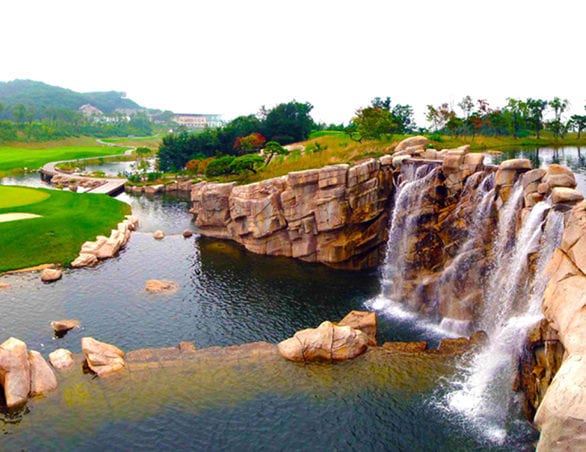Sustainable Water Features in the Built Environment
Posted in Insights -

OTL explains methods that can be used in water-feature design, ensuring fountain and pond operations can be made environmentally sound and sustainable.
While you may have been looking over a four-leaf clover and scheming to catch a leprechaun on St. Patrick’s Day, OTL invites you to ponder this green thought: Can a water feature be a sustainable amenity on your next project? With the right approach, the answer is a resounding Yes!
Designers and developers know that water features can be powerful placemaking attractions in a project, signature elements anchoring public spaces and advancing the narrative of a place. While many people enjoy the ambiance a fountain creates, some question the sustainability of aesthetic water displays. In fact, rather than draining natural resources, water features can actually enhance a project’s sustainability by harvesting rainwater and cleaning stormwater runoff. And while it may sound counter-intuitive, a well-designed water feature will lose less water to evaporation than an equivalently sized lawn area.
Water features can also be designed and constructed to positively affect an environment’s micro-climate. For instance, in hot, arid climates, courtyard water features help moderate outdoor temperatures through the effects of evaporative cooling. Fountains can also take advantage of this effect indoors or, with a higher level of engineering, remove humidity from the air—either of which can help offset air-conditioning use. Water features can also be tied into a building’s cooling system or geothermal system to help moderate temperatures in an aesthetically pleasing manner. Not only are these solutions good for the environment, but systems that reduce resource consumption can lower the long-term operating costs for these properties as well.
OTL has incorporated a number of sustainable design and operation methods into our projects. Through the LEED building certification system, the US Green Building Council awards points to developers for using locally sourced materials that minimize transport and shipping. OTL utilizes local materials and service providers whenever applicable; in addition to the environmental benefits, we believe in supporting business within the areas in which we are working.
While most fountains are filled with potable water that is recirculated, there are alternate sources of water available allowing us to minimize the use of this precious and often scarce resource. Make-up for water lost to evaporation can be collected from HVAC condensate, and filter backwash can be recycled, minimizing discharge into the sanitary sewer. Exterior ponds and fountains can draw from ‘purple pipe’ reclaimed water, depending on their display character and function.
Many of the golf courses for which OTL has built water hazards, streams and waterfalls serve double-duty; while natural in appearance, these manmade water features collect stormwater from across the site and channel it into ponds which also service the irrigation systems. Interactive deck fountains can also be configured to collect rainwater and divert it to cisterns for local irrigation, reducing a site’s stormwater runoff.
Selecting the right water feature equipment can also increase efficiency. OTL standards include high-efficiency pumps controlled with variable-frequency drives (VFD’s), which let us vary pump speed to minimize energy usage. LED light fixtures also use less energy and have a far longer life, meaning maintenance personnel don’t need to re-lamp them nearly as often as had been the case with incandescent fixtures.
Anemometers have long been used to reduce fountain display heights on windy days to minimize overspray, but they can also be programmed in conjunction with thermometers and humidity sensors to reduce spray heights when weather conditions are likely to cause higher evaporation rates. Decisions on filtration equipment are also made depending on system volume to ensure minimal water and chemical usage, while maintaining good water quality. In most instances, for example, a sand filter should not be used on a small fountain as the backwashing cycle will expel a large percentage of the fountain’s water, which in addition to using more water will also lead to excessive chemical usage.
On the subject of chemicals, getting rid of them entirely is a great way to ensure that water features are more environmentally friendly. While not a solution for all applications, some of our fountains and ponds are biologically filtered using natural processes. Chlorine is replaced with aquatic plants and beneficial bacteria creating living environments that harbor a variety of fauna while maintaining crystal-clear water quality.
With social responsibility and sustainable design continuing to inform design concepts for projects of all types, it’s good to know that water features are continually evolving along with this paradigm shift, becoming more efficient by reducing resource consumption. These efforts to maximize performance while minimizing environmental impact and footprint also reduce long-term operational and maintenance costs, meaning that this form of “going green” really can lead to a pot of gold.
Featured Articles
- Getting to Know OTL’s Administrative/Accounting Assistant Nathan Touche
- Centers With Well-Designed Experiential Water Features Can Attract 30,000 Visitors Per Week
- Fountains of Light: California Water Features Developer Opens North Texas Office
- AI and Facility Management: How to Avoid Potential Pitfalls
- Safety First and Last: Creating a Safe Site in any Environment